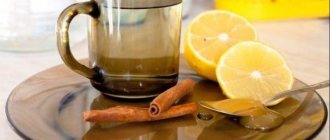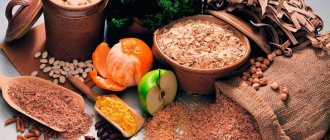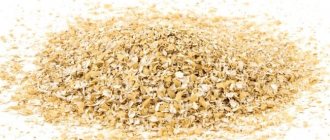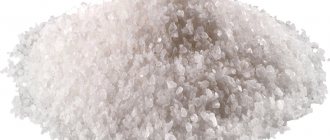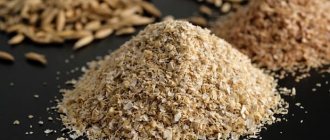Production technologies
In production, only the shell of the amaranth seed (shiritsa) is used. The nucleolus itself is used to produce flour. This separation is necessary for the airiness and softness of the powder, since the shell is too hard and hard (even in a highly crushed form it will be felt in the flour).
After separating the shell, it is crushed and left in this form or pressed into granules. This product is called amaranth bran.
Why is bran better than flour?
When the hard shell of the seed is separated, the bulk of the proteins, vitamins and minerals are also removed. As a result, useless substances remain in the flour, and all valuable substances remain in the bran.
Composition and calorie content
Amaranth bran contains:
- up to 97% coarse dietary fiber (fiber);
- essential amino acids (AA) not synthesized in the body: valine, tryptophan, threonine, tyrosine, lysine, leucine, histidine;
- part of replaceable AKs;
- a large amount of vitamins: E, B1, B2, B5, B6, B9 and PP;
- minerals: magnesium, calcium, potassium, phosphorus, iron.
Comparison of KBJU of various bran (per 100 g):
Exceeding the daily norm of dietary fiber in the diet threatens excess weight and disruption of the gastrointestinal tract (GIT). That's why amaranth and oat bran are the best choice in the diet of healthy nutrition supporters.
Amaranth bran calorie content. What are the benefits of Amaranth Bran?
- Calcium is the main component of our bones, acts as a regulator of the nervous system, and is involved in muscle contraction. Calcium deficiency leads to demineralization of the spine, pelvic bones and lower extremities, increasing the risk of developing osteoporosis.
- Magnesium is involved in energy metabolism, the synthesis of proteins, nucleic acids, has a stabilizing effect on membranes, and is necessary to maintain the homeostasis of calcium, potassium and sodium. A lack of magnesium leads to hypomagnesemia, an increased risk of developing hypertension and heart disease.
- Phosphorus takes part in many physiological processes, including energy metabolism, regulates acid-base balance, is part of phospholipids, nucleotides and nucleic acids, and is necessary for the mineralization of bones and teeth. Deficiency leads to anorexia, anemia, and rickets.
- Iron is part of proteins with various functions, including enzymes. Participates in the transport of electrons and oxygen, ensures the occurrence of redox reactions and activation of peroxidation. Insufficient consumption leads to hypochromic anemia, myoglobin deficiency atony of skeletal muscles, increased fatigue, myocardiopathy, and atrophic gastritis.
List of useful properties
Amaranth bran has a positive effect on the human body:
- They normalize stomach acidity, relieve reflux and prevent exacerbation of gastritis.
- Heal the gastric mucosa, including gastritis and ulcers in remission.
- Thanks to minerals, they strengthen the walls of blood vessels and make them more elastic.
- Due to the content of amino acids, they normalize hormonal levels in women and men.
- Methionine in this bran helps protect the body from the effects of heavy metals.
- They normalize the functioning of the genitourinary system in men and have a positive effect on potency.
- They have an antitumor effect thanks to squalene (a carotenoid that saturates the human body with oxygen), which also prevents premature aging.
- Tryptophan in the composition stimulates the production of insulin, accelerates metabolism and is involved in hematopoiesis.
- Cleanses the intestines of toxins and undigested food debris.
- Act as an absorbent and prevent the absorption of “bad” cholesterol into the blood.
- Provide assistance in the treatment of enuresis in adults and children.
- They prevent malignant neoplasms by removing free radicals and toxins from the body.
- They have antimicrobial properties and restore intestinal microflora.
- Prevent osteoporosis due to the high content of calcium, iron and magnesium.
- They promote weight loss, since even a small portion of bran can fill you up for a long time.
Amaranth bran can be consumed by people with celiac disease, since the product does not contain gluten.
Amaranth bran. What are the benefits of amaranth bran and what are they eaten with?
I can’t calmly walk past the diet food section at the supermarket. And then some new bran, and the inscriptions scream: “Take us! We are very helpful!”
The packaging is interesting, visible, and catches the eye. And when I read about the benefits of amaranth bran, I had no doubts about purchasing it at all.
I have known about the benefits of oat/wheat/rice bran for a long time, but I have never heard anything about amaranth bran. And I didn’t even know what kind of animal amaranth was. But it turned out that this is a plant with beautiful “earring” flowers, which I have seen more than once in warm regions. In fact, it is what is shown on the box.
Amaranth bran with Jerusalem artichoke reduces the concentration of glucose and cholesterol in the blood. Gluten free. 100% natural product, without GMOs, dyes and preservatives
The most important advantage of amaranth is its record squalene content (up to 6%). Squalene is a powerful antitumor substance. Regular consumption of amaranth bran with Jerusalem artichoke is recommended for people suffering from: frequent headaches, insomnia, diseases of the nervous system, inflammatory diseases of the kidneys and other organs of the urinary system, diseases of the oral cavity (stomatitis, periodontitis), hemorrhoids, tuberculosis, diseases of bones and joints (rickets, osteoporosis, articular rheumatism, polyarthritis, etc.), diseases of the organs of vision (conjunctivitis, night blindness, cataracts, diabetic retinopathy, etc.). Flour and bran from amaranth grains contain a high content of the most important macro- and microelements for the human body - iron, potassium, phosphorus, calcium, magnesium and copper (it is worth noting that in terms of the concentration of iron, potassium and copper, amaranth flour is many times higher than flour from wheat).
In principle, the composition is pleasing, the calorie content is the same as that of cereal, but 100 g. It’s unlikely that anyone will eat bran at once.
Ingredients: coarse amaranth flour, coarse corn flour, coarse rice flour, dried Jerusalem artichoke, flaxseed flour, milk thistle flour, water, salt.
Energy value per 100 g:
calorie content - 311 kcal,
proteins - 20.4 g,
fats - 5.1 g,
carbohydrates - 67 g.
The bran looks like gray, slightly porous balls (almost like Nesquik breakfast. In the box, the bran is divided into 2 bags, apparently for convenience.

The taste is ordinary bran, without a pronounced taste, not unpleasant, odorless, but it leaves a light, pleasant nutty aftertaste. At least that's what it seemed to me.
You can just crunch it like that, but for me it’s tasteless. You can pour it with milk, but I fill it with kefir or fermented baked milk. It turns out edible, but to make it absolutely delicious, I mix them with muesli. First, I pour kefir over the muesli so that it softens, and right before eating, I add amaranth bran. It turns out sweet due to the muesli, and the bran has a pleasant crunch and gives a light nutty taste. I also tried bran with fermented baked milk and banana, also delicious. In general, there is a whole field for experimentation here!

After such a breakfast you will feel full for a long time!
I’ll say right away that this is not a delicacy, it’s not for everyone (my husband, for example, didn’t even look at them), this is a healthy product for those who are ready to eat healthy and not entirely tasty in the generally accepted sense.
Possible harm
Bran from amaranth seeds is prohibited for the following diseases in the acute stage:
- gastritis and ulcers;
- pancreatitis;
- duodenitis;
- colitis;
- adhesions in the abdominal cavity;
- other acute gastrointestinal diseases.
The product is contraindicated for diseases of the digestive tract in the acute stage, since the dietary fiber in the composition accelerates intestinal motility and aggravates the patient’s condition. You can add bran to your diet only during the period of remission, starting with small portions.
The product should be consumed with caution by people suffering from allergic reactions and pregnant women (an active intestine can increase the tone of the uterus).
Amaranth balls. Nesquik for desperate PP girls
I am incredibly pleased that recently more and more food items have appeared that are adapted to proper nutrition. People who adhere to their regime and “clean” nutrition, like everyone else, want variety in food)
But, unfortunately, marketing does not lag behind the fashion for proper nutrition. Manufacturers vying with each other to sign magic words on their products: “fitness”, “slim”, “light”, etc. - although a good half of these products have a very dubious relationship to sports, fitness and PP. Therefore, every new fitness product causes not only joy, but also fear. Before you grab something from the counter, the first thing to do is read the ingredients!
A couple of days ago I came across an interesting product - amaranth breakfasts. I definitely couldn’t pass by, because I haven’t eaten standard breakfast cereals for a thousand years, although I dream about them from time to time)) Judging by the picture on the packaging, these breakfasts look like Nesquik, the same chocolate balls. At the same time, on the same packaging there were a bunch of beautiful words:
wholemeal flour, gluten-free, yeast-free, sugar-free
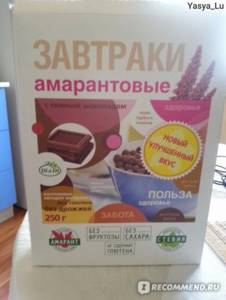
Package
Well, you can’t fool us with advertising words! Let's look at the composition:
amaranth bran, amaranth flour, corn flour, rice flour, dried Jerusalem artichoke, flaxseed flour, milk thistle flour, chocolate glaze, stevia extract, salt
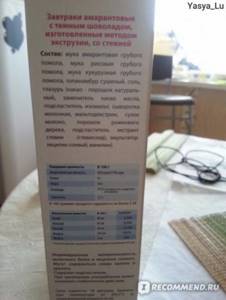
Compound
Well, the composition is more than decent! Moreover, even chocolate icing in its composition does not have anything particularly criminal. The main ingredient is amaranth bran and flour. These are foods with a low glycemic index. There is a lot of information on the Internet about the benefits of amaranth - if you believe all this, then you should directly rub yourself with amaranth, it is so magical!))) But for me personally, the decisive factor was the complete absence of sugar, I avoid it in every possible way.
In general, after studying the composition of the product, I decided to definitely try it. There were two flavors to choose from: dark chocolate and white chocolate. I took dark chocolate - if Nesquik, then to the end!)) The package cost me 74 rubles, which is for 250 grams.
Upon arriving home, I continued to visually examine the packaging)) According to the KBZHU, we have 350/8.7/18/66 here. The product is high in calories and also quite fatty, due in particular to the flaxseed flour in the composition. But this is breakfast; from the point of view of a morning meal, the nutrient composition is just right.
I open the cardboard package - inside are two bags of the same size with the treasured chocolate balls. In my opinion, it’s more convenient to store this way - it takes up less space. I immediately threw away the cardboard box.
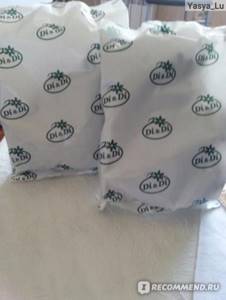
Packages inside
Now let's move on from visual observations to tasting. For my breakfast I take 40 grams. chocolate balls (according to the KBJU we have 172/3.6/7.2/22), and 100 ml of milk (I have Parmalat 0.5%) - accordingly, this package is enough for me for 6 breakfasts.
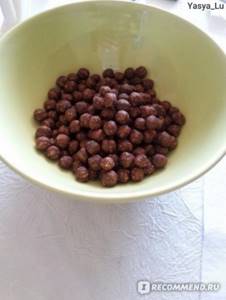
40 gr. chocolate balls
I filled the balls with milk and waited 5-10 minutes. Here's a picture:

40 gr. breakfast + 100 ml. milk after 10 minutes
The milk was not particularly colored with chocolate, as is the case with Nesquik. The balls themselves also did not soften much.
Now as for the taste. For me - very good. Not Nesquik, of course, but similar. The balls themselves seem to be covered in a greasy film - a coating of chocolate glaze. Sweet, chocolatey - what else do you need on a diet?!)) By the way, the taste of stevia is not noticeable. I don’t like the taste of this herb, so for me this is a definite plus.
In general, my summary: such a breakfast has a place in the diet! As a change between oatmeal and oatmeal, it's just wonderful. After all, even the most notorious police officers sometimes want chocolate in the morning))
Application for weight loss
Various amaranth products have long gained popularity in eastern countries. There they are eaten by most of the population. Connoisseurs are sure that these tiny seeds have a positive effect on the digestive tract, normalize metabolism, promote weight loss and maintain a healthy weight.
The dietary properties of amaranth bran are due to:
- a large amount of coarse fibers that accelerate digestive processes in the body;
- the ability to create a feeling of satiety without an excess of calories (they do not contain flour, yeast and other energy-intensive ingredients);
- absorbent effect (fiber cleanses the intestines of toxins and undigested residues, reduces cholesterol levels).
How to use correctly
In the absence of contraindications, to lose weight, you should follow the recommendations:
- Gradually increase the portion, starting with ¼ daily dose.
- Do not exceed the daily norm.
- Drink at least 2 liters of clean water during the day (with less liquid, constipation is possible).
- Immediately before use, be sure to soak the granulated bran in hot water.
Bran
This is the hard shell of grain that remains after it has been processed during flour milling.
Due to its high fiber content, this product is classified as low-calorie - from 110 kcal per 100 g, depending on the cereals used. It contains various vitamins, minerals, saturated and unsaturated fatty acids and proteins of plant origin, which allows it to sometimes be used as a complete food product. For example, instead of breakfast in the morning, like porridge, steam it with boiling water or eat it with kefir. The main beneficial properties of bran are associated specifically with the effects of fiber:
- They remove harmful substances and waste from the body.
- Helps restore healthy intestinal microflora.
- Reduce the likelihood of diabetes or the manifestation of its symptoms.
- They reduce cholesterol levels in the blood, which helps normalize the functioning of the cardiovascular system.
- They have a positive effect on the condition of the urinary and lymphatic systems.
- Activate digestive processes in the intestines.
- They promote weight loss, both through their effect on the gastrointestinal tract and due to their ability to swell and reduce hunger.
B vitamins contained in bran affect the process of hematopoiesis and the functioning of the nervous system.
The presence of vitamins A and E in this product provides:
- Improving the functioning of the immune system, and protecting against colds, group, various infections of the respiratory system, digestion and urinary system.
- Restoring healthy skin and hair.
- Preservation of visual acuity.
- Normalization of progesterone production and improvement of hormonal balance.
- Positive effect on blood circulation.
- Improved regeneration.
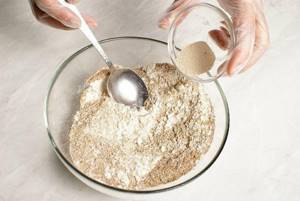
Contraindications
Bran has limitations in its use. They are prohibited for use in the presence of acute inflammatory or infectious diseases of the gastrointestinal tract, such as:
- Gastritis and stomach ulcers during exacerbation.
- Pancreatitis.
- Inflammation of the duodenum.
- Colitis.
- Intestinal diseases.
And also if there are adhesions in the abdominal cavity.
This product should not be used if you are hypersensitive to it. During pregnancy, it is important to follow the dosage, since activation of the intestines can affect the tone of the uterus. You should not take bran in parallel with medications, as they can absorb and remove the drug before it enters the bloodstream and begins to act.
And even in the case of a healthy body, it is necessary to follow the rules of administration and dosage of this type of fiber:
- Don't start with a large amount at once. In the first days, 1 tbsp will be enough. spoons, then gradually increase the dose to 3 tbsp. spoons.
- Do not forget to drink enough clean water - more than 2 liters per day. Dilute the product with water or kefir. Or drink it after taking it if you eat it in granules.
- Remember that you need to take breaks from taking it.
Types of bran
According to the form of release they are:
- Rough. They have a good effect on the lower part of the intestine, blood supply to the pelvic organs, and help reduce the overall sludge load in the body. Available in granule form.
- Thin. Regulates the functioning of the stomach, duodenum, and pancreas. Improves food digestibility and normalizes metabolism. Used for making porridge and baking.
Depending on what grain it is produced from, bran comes in the following types:
- Oatmeal.
- Rye.
- Amaranthaceae.
- Rice.
- Linen.
- Corn, etc.
They are also distinguished by the components used, which enhance and complement the effects of the main ingredient:
- Without anything.
- With milk thistle.
- With Jerusalem artichoke.
- With kelp and other additives.
Each of the above types has its own characteristics and properties. For example, barley has a better effect on the cardiovascular system, as it includes more fine fiber, which binds fatty acids in the intestines and reduces cholesterol levels. Wheat, due to its structure, helps with constipation, etc. But they all contain coarse fiber, amino acids, minerals and vitamins, and will undoubtedly be beneficial to your body.
Varieties
On store shelves you can find several options for amaranth bran.
They differ in production technology (the degree of crushing of the grain shell) and the effect on the human body:
- The fiber in a coarse product has a greater impact on the lower intestinal segments. Improves blood circulation in the pelvic organs (by accelerating peristalsis) and removes harmful substances from the body. Most often available in granules.
- Finely ground bran begins its work in the stomach and duodenum. Thanks to them, food is better absorbed and metabolism accelerates. The texture is powdery, reminiscent of whole grain unrefined flour.
Each of the release forms has its own advantages:
- Granules are convenient to use for quick breakfasts and snacks. They can be consumed dry, simply washed down with enough water (but it’s better to soak them first).
- Flour is intended for adding to pastries, bread, pancakes or porridges from other cereals. This option is suitable for those who do not like the taste of amaranth.
Which bran is best for weight loss?
They appear in the following form:
- In granules. Does not require additional processing. They are often added to various drinks and dishes. But when purchasing, you should take into account the composition; these products often contain unnecessary additives, enhancers and taste improvers. In addition, this form of release usually costs more.
- Ground. They have a positive effect on the functioning of organs in the upper part of the gastrointestinal tract: liver, stomach, pancreas, duodenum, accelerate digestion and improve the digestibility of food. Although in general its usefulness is lower than that of coarser grinds. Flour from it is often used for baking.
- Large ones. This is the most useful dietary supplement option. It regulates the functioning of the lower intestine, normalizes blood supply to the pelvic organs, and also helps in general cleansing of the body.
There are bran powders on sale with the addition of fruits, berries, nuts, seeds: pumpkin, sunflower, flax or milk thistle. The presence of such components enhances the effect of fiber and significantly accelerates the process of losing weight.
Various products and semi-finished products with the addition of bran are also produced. Among them there are breads, cereals, muesli, cereals, cookies, bars. They will not bring significant benefits, but they are quite convenient to replace more harmful sweets and fast food.
Amaranth benefits and harms, beneficial properties, how to use
The ancient tribes of the Aztecs and Incas grew "amaranth" for their special rituals. He was also involved in sacrifice. However, the Spaniards who came to the “New World” eradicated this use of this plant. The conquistadors nicknamed this plant “the devil’s flower.”
The Aztec emperor himself ate amaranth oil and its seeds. Amaranth grains were equated to gold. The ancient Aztecs believed that taking amaranth seeds strengthens the human spirit and body. Weak newborns were also given amaranth seeds as their main food. The Indians truly idolized and worshiped amaranth. They were deeply convinced that eating amaranth would grant them immortality and power. Even in ancient Greece, the amaranth flower was associated with immortality.
In general, amaranth comes from South America. The largest number of amaranth species, its forms and varieties grow there.

Now amaranth has a second name “shiritsa”
and it is an agricultural crop. In general, it is believed that amaranth grain contains even more nutrients than wheat.
This interesting plant was brought to Russia by Academician N.I. Vavilov. This happened after his trip to Mexico. He tried to draw the attention of agronomists to amaranth. However, they started talking about him again only in the early nineties. At the beginning of the twentieth century in Rus', amaranth was used as feed for cattle, and very rarely people consumed its greens. But now there are already huge fields of amaranth in Russia, and gardeners are also keen on growing this plant.
Amaranth is one of the plants that bind carbon dioxide from the atmosphere in large quantities. Considering the current state of the environment, this is another big plus in the collection of beneficial properties of amaranth. Scientists have found that acorn grass can cleanse the soil of heavy metals.
Still, the Spaniards did not manage to wipe this interesting plant off the face of the earth, which we will talk about below.
Reviews
Elena. I’ve long heard that bran is good for health, but I only recently learned about amaranth bran. I had no idea what this mysterious plant looked like. The bran from it turned out to be the most ordinary: crispy, odorless balls. The only difference is the nutty aftertaste. I like to mix them with granola and top them with sweet yoghurt. It makes a delicious and healthy breakfast.
Marina. Walking around the supermarket, I looked at the new products on the shelves. In the healthy food department, amaranth bran caught my eye. Their beneficial properties were so temptingly described on the packaging that I decided to try it. Tastes like unsweetened breakfast cereal. This is how I use them, pouring milk over them. And my son just likes to crunch on the go.
Michael. My relatives from the Far East reminded me of a wonderful plant - amaranth. After studying the information, I decided that the highest concentration of useful substances is contained in the shell of its seeds. I buy them finely ground and add them to homemade bread, porridge, and make smoothies. It’s been several years since this product has found its way into my diet.
Oksana. Every year there is a “miracle product” that advertising gives a lot of useful properties. Recently, amaranth bran turned out to be such a food. I couldn't resist the marketing shills and decided to give it a try. They have practically no taste, as well as smell. Digestion has indeed become somewhat better, but there are also disadvantages - excessive hardness and slight bitterness.
Amaranth beneficial properties and composition
Amaranth is rich in proteins and amino acids. Particularly important among them is lysine. Lysine has a positive effect on the functioning of the cardiovascular system, glands, and fermentation. Lysine helps in the production of antibodies, and even helps in killing viruses. Another element that makes up amaranth is methionine. Methionine protects the body from heavy salts, and tryptophan improves metabolic processes. Squalene is a rather rare element, but it is also included in amaranth.
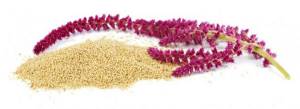
It prevents the formation of cancer cells, which is why it is so good for the prevention of cancer. Thanks to squalene, the body's defense mechanisms are activated much more strongly. Squalene helps fight skin diseases; it is also effective in tissue regeneration. Linoleic acid, which is part of amaranth, helps stabilize blood pressure. Amaranth also contains linoleic and oleic acids. Tocopherol, which is also found in this plant, helps fight cholesterol.
Tocopherol also helps remove free radicals from the body. One cannot help but recall the vitamins contained in amaranth. These are vitamins A, ascorbic acid, and others. It is also rich in minerals, zinc, calcium, magnesium, and others.
Amaranth bran with kelp. Composition and benefits of Di&Di amaranth bran with kelp
The product contains: amaranth bran, amaranth flour, corn flour, rice flour, dried kelp, salt. As noted on the packaging, the bran is extruded and gluten-free.
Content of useful elements in 100 grams: mono and disaccharides – 2 g, starch – 64 g, fiber – 4 g, ash – 3 g, sodium – 6.48 mg, potassium – 147.5 mg, calcium – 70 mg, magnesium – 44 mg, phosphorus – 116.4 mg, iron – 2.12 mg, iodine – 0.21 mg.
Amaranth is known for its easily digestible vegetable protein. The plant is rich in polyunsaturated fatty acids, omega-3 and omega-6. It is noteworthy that amaranth is an excellent source of choline and tryptophan, which promotes the production of the joy hormone - serotonin (calorifier). In terms of protein, fiber and mineral content, amaranth exceeds wheat by 1.5 times, 3 times and 4 times (respectively).
Amaranth bran is especially valuable for its high content of squalene, an element that neutralizes free radicals in the body and also removes other carcinogens and toxic substances that cause the development of cancer. In combination with kelp, the product is recommended in the diet for diseases of the thyroid gland and cardiovascular system.
Contraindications to the use of amaranth bran may include periodontal disease and other diseases of the teeth and gums: the product is quite harsh and can cause injury to the oral cavity when chewed.
Use of amaranth
- One spoon of amaranth juice contains the right amount of nutrients for a child. However, you need to monitor for possible allergic reactions.
- Amaranth juice is beneficial for the female body and protects against cancer of the female reproductive system. It also helps with critical days and relieves pain. Amaranth juice is recommended for women planning pregnancy. It reduces the possibility of developing brain defects.
- Children and adults drink amaranth juice to treat the upper respiratory tract.
- Amaranth juice lowers blood cholesterol levels.
- It is used to prepare a remedy to combat skin problems such as eczema.
- B vitamins, which are contained in amaranth in decent quantities, help for high-quality brain function.
- For the prevention of osteoporosis.
- For positive functioning of the gastrointestinal tract.
- It has been proven that products from this plant have a beneficial effect on blood vessels, strengthen the walls of blood vessels, preventing varicose veins.
- If you germinate amaranth seeds, they can be used to increase male power. After consuming such seeds, men's sexual activity increases.
- Has a diuretic effect.
- Amaranth sprouts bring the hormonal system back to normal.
- Brings the body into general tone.
Amaranth in cooking
Porridge is made from amaranth. To do this, take a glass of seeds and three times the volume of water. The water is brought to a boil and amaranth seeds are poured into it. You should wait until the grains float to the surface, and then until they fall to the bottom. It is advised to cover the pan with a lid so that the grains do not explode and fly out. The seeds are boiled for forty minutes. This porridge turns out to be tender in taste. In addition, it is very rich in proteins, fats, and other elements.

The leaves of this plant are also edible. They are most often used to make salads. It is advisable to boil them in boiling water. Ready leaves are added to side dishes and salads. They are also eaten pure with butter. Starch from this plant is used for baking and preparing fermented milk dishes.
A healthy tea is also made from the leaves. They are dried and then steamed.
Amaranth is also used as silage and feed for pigs and poultry.
To prepare pancakes from amaranth flour, take 50 g of this very flour, mix with wheat flour, half a liter of kefir, and an egg. Add baking powder and salt with sugar.
Bread is also made from flour. To do this, you need 100 g of amaranth flour, 350 g of wheat flour, and 50 g of bran. Add half a liter of water and three tablespoons of yeast. Next, vegetable oil and salt with sugar, two tablespoons of each. Mix it all into a homogeneous mass and put it in a warm place for a couple of hours. When the dough has risen, it is transferred to a mold and sent to the oven. Bake the bread for about half an hour at an oven temperature of 200 degrees. The bread turns out very tasty and healthy.
Amaranth in cosmetology
The lipids that make up amaranth are of great interest for cosmetology. Amaranth oil is obtained from amaranth seeds. The oil contains substances such as fatty acids, tocopherols, and phytosterols. Using amaranth oil you can achieve the following effects: rejuvenate the skin, give it elasticity, protect sensitive skin, moisturize the epidermis, cleanse, and even improve the condition of nails and hair.
The simplest use is to add a couple of drops of oil to a care product (shampoo, cream). You can also simply smear the oil onto the skin and then rinse it off.
A mask made from amaranth and sour cream will help you against peeling skin. To do this, you need to mix these ingredients in a ratio of three to two. A homogeneous mixture is applied to the affected areas of the skin.

To narrow pores, a mask made of clay and amaranth oil will help. The amount of oil should be twice the amount of clay. The mixture is applied to a steamed face and washed off with warm water after twenty minutes.
Massage therapists can also use this oil for their work. It will greatly soften the skin and give elasticity. Amaranth oil will also help you fight dry skin. To do this, you need to mix melted honey and a couple of tablespoons of amaranth oil. Then apply to facial skin and leave for 10-15 minutes. The mixture should be absorbed, and what is not absorbed should be washed off with water.
Breakfast and snack recipes
It doesn’t take much time to prepare a complete breakfast or snack using bran.
On a note. The product must be soaked in hot water in advance, soaked for 15–20 minutes and drained. If bran is consumed in dry form, it should be washed down with a sufficient amount of water or other liquid in a ratio of 1:3.
Kefir/orange drink
Mix 250 ml of low-fat kefir or the same amount of freshly squeezed orange juice with 1 tbsp. l. bran. Shake well and drink immediately without waiting for sediment to form.
Fruit smoothie with yogurt
Place 1 tbsp in a blender bowl. l. bran, 2 small peeled kiwis, 1 banana, 300 ml natural yogurt. Whisk all ingredients and serve.
Buckwheat porridge with milk
Prepare milk buckwheat porridge according to the classic recipe: for ½ cup of dry buckwheat, 1 cup of milk, salt and sugar to taste. Place the soaked bran in the finished dish and stir.
Buckwheat with kefir - benefits and harm.
Porridge with raisins and pumpkin
Boil 200 g of pumpkin, beat it in a blender with 1 tsp. raisins and 1 tbsp. l. pre-brewed bran. Pour the mixture with hot milk (250 ml). Stir and serve.
Simple vegetable salad
Cut 1 tomato and 1 cucumber into small cubes and tear the salad mix with your hands. Prepare dressing from 1 tbsp. l. amaranth oil, 1 tsp. lemon juice, salt and pepper. Mix the vegetables, add bran granules and pour the dressing over the salad.
Advice. The bran in this recipe does not require pre-soaking, but the dish must be washed down with at least 200 ml of liquid.
Pancakes
For preparation, you can take only finely ground amaranth bran or mix it with oat and corn bran. At 2 tbsp. l. product required: 1 egg white, 1 tbsp. l. low-fat yogurt or kefir. Mix all ingredients until smooth, let it brew and fry in a non-stick frying pan without oil. Pour natural yoghurt over the finished pancakes and garnish with berries.
Okroshka
Finely chop 1 cucumber, 1 medium boiled beet, 2 eggs and a bunch of mixed herbs (dill, parsley, green onions). Dilute 300 ml of 1% kefir half and half with water and pour it over the vegetables. Add amaranth granules, stir and pour into bowls.
Amaranth meal
After squeezing out all the parts of the amaranth, what remains is amaranth meal, the so-called flour. It contains proteins and fiber, which makes it even more healthy.
This product contains a large amount of fiber. If you eat amaranth meal every day, you can get rid of excess weight.
It is recommended for children and even pregnant women to take it. Amaranth meal is also recommended for people with vision problems, because it also prevents the occurrence of cataracts.
Contraindications to the use of amaranth meal
There are cases in which the use of amaranth meal is not recommended. For example: individual intolerance, kidney stones and cholecystitis.
People with liver disease are also not recommended to start treatment with this product.
Recipes with amaranth bran
Bran with kefir
Kefir 1% fat – 250 ml Steamed amaranth bran – 1 tbsp. lie
Pour a spoonful of bran with a small amount of boiling water, let it brew for twenty to thirty minutes, strain and add to a glass of kefir. Stir well. And the drink is ready.
Amaranth with freshly squeezed orange juice
Steamed bran – 1 tbsp. Juice of two oranges
Squeeze the juice from oranges, add steamed bran, stir.
Buckwheat porridge with amaranth and milk
Boiled buckwheat porridge – 150 g Steamed amaranth bran – 1 tbsp. lie Milk 1% fat – 1 tbsp.
Add amaranth bran to buckwheat porridge, add milk and stir.
Amaranth bran with pumpkin, raisins and milk
Steamed amaranth bran – 1 tbsp. lie Boiled pumpkin – 200 g Raisins – 1 tsp. Low-fat milk – 250 ml
Place the boiled pumpkin in a blender, add raisins and bran, pour milk over everything and mix.
Smoothie with bran, kiwi, banana and yogurt
Steamed amaranth bran – 1 tbsp. lie Kiwi – 2 pcs. Ripe banana – 0.5 pcs. Natural low-fat yogurt – 300 ml
Peel the kiwi and banana, puree in a blender, add bran and yogurt. Beat it all together.
Salad with amaranth bran
Salad mix – 150 g Fresh cucumber – 1 pc. Fresh tomato – 1 pc. Olive oil – 1 tbsp. lie Lemon juice - 1 tbsp. lie Ground black pepper and salt - to taste
Dice the tomato and cucumber, put in a salad bowl, add the salad mix, sprinkle with bran, salt and pepper, pour over lemon juice and olive oil, mix everything.
Video about the properties and use of amaranth
Contraindication
- Not recommended for stomach and intestinal ulcers.
- If you have an individual intolerance to this product.
- For diarrhea and kidney disease.
- You should not consume more than the specified norm, as you can get such a nuisance as constipation.
The most useful bran for weight loss
Don't forget about such a useful natural product as amaranth bran. After all, they not only reduce the feeling of hunger, but also fill the body with nutritious minerals, strengthen the immune system and cleanse the intestines of “biological waste”.
Cereal Bran
The benefits and harms of rice bran
The most useful form of gluten is found in rice. In the human body, gluten is integrated into amino acid metabolism.
Rice has been known as a detox food since ancient times. Bran from it can really remove all “poisons” from the body, including elements of the breakdown of antibiotics, alcohol, heavy metal salts, and cholesterol.
With regular consumption of rice bran:
- chronic fatigue gives way to energy;
- immunity is strengthened;
- the depressive state is replaced by a good mood;
- weight loss occurs;
- blood composition improves.
Rice is rich in selenium, copper and zinc, B vitamins, so it is not surprising that rice bran:
- treat atherosclerosis and increase the elasticity of blood vessels;
- improve liver function.
To summarize, we can say that rice bran is completely harmless to the human body if it is not abused (in this case, intestinal function will worsen).
Women use rice bran crushed into dust to prepare homemade scrubs (for example, with cream) that help rejuvenate the skin.
Bran with kelp

Kelp - or seaweed as it is also called - is one of the best additives in the production of bran for weight loss. Regardless of the type of processing, it retains up to 80% of its beneficial substances. 20% of them are fructose polysaccharides, and the rest are vitamins of groups B, C, D and E, phosphorus, iron, zinc, magnesium, iodine and other useful substances.
Sea kale acts as a mild laxative, allowing you to gently cleanse the body of toxins and waste. The large amount of iodine it contains makes it an excellent remedy for the prevention of diseases of the thyroid gland and endocrine system. It contains alginates, which allows the removal of toxic substances from the body, and allows it to be used for the prevention of malignant neoplasms. In general, its action coincides with and enhances the effect of using fiber.
On sale you can find oat, wheat, amaranth bran and kelp. The combination of the main components in the latter case provides a particularly effective effect on metabolism; the combination of amaranth fiber and seaweed makes this product a powerful antitumor agent. Which helps in cleansing the body of radionuclides, metal salts, carcinogens, improves the condition of the walls of blood vessels and reduces blood sugar levels.
Di&Di Corporation offers two types of this product. It is simple to use such amaranth bran with kelp: just like any other grocery product of this type, they can be added to jelly, yoghurt and kefir, vegetable dishes, porridge, and when baking.
The benefits and harms of buckwheat bran
The energy value of the product is 365 kcal per 100 g, about 35 kcal per 1 tablespoon. This calorie content is acceptable even for the most strict diet.
Buckwheat is a storehouse of iron, without which any weight loss threatens to end in anorexia.
Adding bran from it to any dish greatly increases the satiety of the meal. Also buckwheat bran:
- increase the density of bone tissue and the strength of tooth enamel;
- protect against anemia;
- normalize the transmission of nerve impulses literally from head to toe;
- accelerate the regeneration of damaged tissues.
Most of the proteins are concentrated in the core of buckwheat grains, but the shell of the bran also contains essential amino acids that serve as “building materials” for the entire body.
With prolonged use, buckwheat bran can provoke an exacerbation of chronic skin diseases (but this is mild).
How to cook and eat
Amaranth bran can be consumed independently; to do this, pour one tablespoon of bran into a glass of boiling water and let it brew for about thirty minutes. Then filter. And the gruel is ready for use.
To avoid constipation, you should always drink at least a glass of water after eating bran. Also, steamed bran gruel can be added to salads, drinks, juices, kefir, yogurt, fruit smoothies, soups and dietary baked goods.
How to make and use amaranth flour



